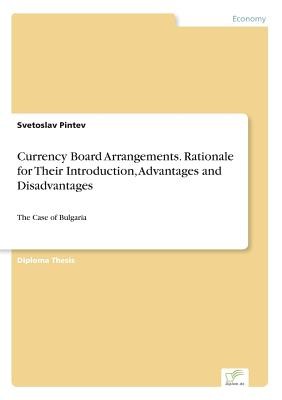
- We will send in 10–14 business days.
- Author: Svetoslav Pintev
- Publisher: Diplom.de
- Year: 2003
- Pages: 84
- ISBN-10: 383866549X
- ISBN-13: 9783838665498
- Format: 14.8 x 21 x 0.5 cm, softcover
- Language: English
- SAVE -10% with code: EXTRA
Currency Board Arrangements. Rationale for Their Introduction, Advantages and Disadvantages (e-book) (used book) | bookbook.eu
Reviews
Description
Inhaltsangabe: Abstract: Currency board arrangements, under which domestic currency can be issued only to the extent that it is fully covered by the central bank's holdings of foreign exchange, were long generally dismissed as throwbacks to the colonial era. It was argued that such a rigid, rule-based arrangement was not well suited to diversified economies in many of which the authorities had developed sophisticated skills in monetary management. Instead, currency boards were seen as desirable in very small open economies (such as city-states for example). In 1960, 38 countries or territories were operating under a currency board. By 1970, they were 20 and, by the late 1980s, only 9. In the last decade the interest for Currency Board Arrangement (hereinafter CBA) renewed because of its simplicity, transparency, and rule-bound character. It became evident after the successful efforts made by two transition economies-Estonia and Lithuania-which quickly managed to achieve credibility for their newly established currencies. In 1997, a currency board arrangement was introduced in Bulgaria to end the economic crisis. Soon after, Bosnia and Herzegovina followed. In 1998 there have been discussions on establishing a currency board arrangement in Russia. More recently the newly appointed Finance Minister of Poland initiated a debate on pegging the Polish zloty to the euro through a CBA. This paper previews the history of the colonial and modern currency boards and presents the benefits of such a system for the newly emerged transition economies in Eastern Europe and Bulgaria especially. First, we will present a brief description of the currency board system. Currency Board Arrangements after falling into oblivion during much of the post-war period, staged a remarkable comeback mainly in Central and Eastern Europe countries. Estonia, Lithuania, Bulgaria and Bosnia and Herzegovina have introduced this particular monetary framework and as a result have managed to break infl
EXTRA 10 % discount with code: EXTRA
The promotion ends in 20d.00:19:49
The discount code is valid when purchasing from 10 €. Discounts do not stack.
- Author: Svetoslav Pintev
- Publisher: Diplom.de
- Year: 2003
- Pages: 84
- ISBN-10: 383866549X
- ISBN-13: 9783838665498
- Format: 14.8 x 21 x 0.5 cm, softcover
- Language: English English
Inhaltsangabe: Abstract: Currency board arrangements, under which domestic currency can be issued only to the extent that it is fully covered by the central bank's holdings of foreign exchange, were long generally dismissed as throwbacks to the colonial era. It was argued that such a rigid, rule-based arrangement was not well suited to diversified economies in many of which the authorities had developed sophisticated skills in monetary management. Instead, currency boards were seen as desirable in very small open economies (such as city-states for example). In 1960, 38 countries or territories were operating under a currency board. By 1970, they were 20 and, by the late 1980s, only 9. In the last decade the interest for Currency Board Arrangement (hereinafter CBA) renewed because of its simplicity, transparency, and rule-bound character. It became evident after the successful efforts made by two transition economies-Estonia and Lithuania-which quickly managed to achieve credibility for their newly established currencies. In 1997, a currency board arrangement was introduced in Bulgaria to end the economic crisis. Soon after, Bosnia and Herzegovina followed. In 1998 there have been discussions on establishing a currency board arrangement in Russia. More recently the newly appointed Finance Minister of Poland initiated a debate on pegging the Polish zloty to the euro through a CBA. This paper previews the history of the colonial and modern currency boards and presents the benefits of such a system for the newly emerged transition economies in Eastern Europe and Bulgaria especially. First, we will present a brief description of the currency board system. Currency Board Arrangements after falling into oblivion during much of the post-war period, staged a remarkable comeback mainly in Central and Eastern Europe countries. Estonia, Lithuania, Bulgaria and Bosnia and Herzegovina have introduced this particular monetary framework and as a result have managed to break infl


Reviews